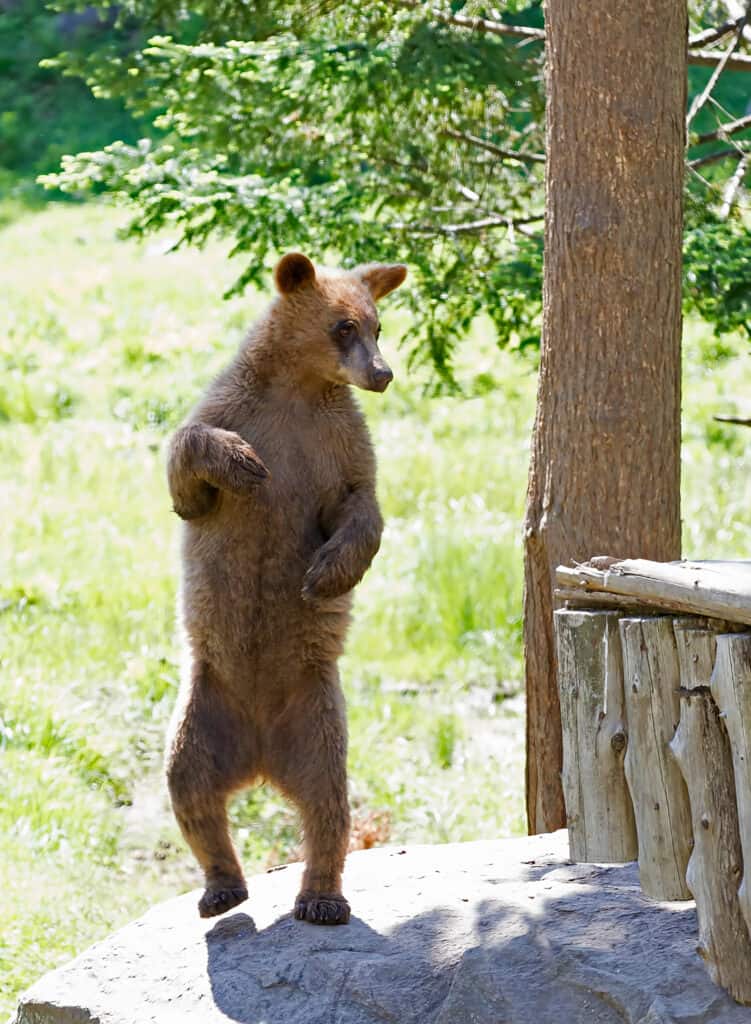Cinnamon Bear (original) (raw)
“Cinnamon bear cubs don’t always look like their moms. They can be black, brown, or reddish-brown.”
Cinnamon Bear Summary
Cinnamon bears are named for the warm brown color of their fur. They are a subspecies of the North American black bear. Besides their color, this species differs from black bears in that they tend to be found in more arid climates. But these bears may coexist in the same habitats and interbreed. When they do, they may have cubs that are black, brown, or reddish-brown. Although their habitat is not as large as it once was, these bears are not considered an endangered species at this time.
Cinnamon Bear Facts
- The cinnamon bear is a subspecies of the American black bear, the smallest North American bear species.
- They can interbreed with black bears and have cubs of different colors.
- Mothers give birth to 2-3 cubs in the winter while they hibernate.
- Newborn cubs weigh only 1/2 pound — the weight of a large apple.
- Poachers sell bear parts, including paws and gall, for use in traditional Asian medicine.
Cinnamon Bear Scientific Name
The scientific name is Ursus americanus cinnamomum.
It is from the Ursidae family of the Mammalia class.
Cinnamon Bear Appearance
These beautiful bears have brown or reddish-brown fur that looks like cinnamon spice. Its coat is thicker, longer, and finer than that of the black bear.
Their size is comparable to that of black bears. They stand 3 feet high at the shoulder when they are down on all fours, and they weigh anywhere from 200-600 pounds. Males are larger than females. The bears are heavier when food is abundant, especially in the fall when they pack on pounds to prepare for hibernation.
Cubs weigh only half a pound at birth! That’s about the weight of one large apple.

A young cinnamon bear stands at full height to peer over the ledge.
©Jim Cumming/Shutterstock.com
Cinnamon Bear Behavior
Like other bears, they are nocturnal – they sleep during the day and become active at night. They are especially active around dawn and dusk, and are great climbers, runners, and swimmers.
These bears are usually solitary creatures, with the exception of mothers who are still nursing cubs.
They hibernate during the winter. Depending on how cold the weather is, they start hibernating in late October or early November and don’t emerge from their dens until March or April.
Cinnamon Bear Habitat
They live mainly in forests in both the lowlands and mountains. They tend to be more common in drier, more arid regions, while black bears prefer moister forest conditions. The brown fur of the cinnamon bear provides advantageous camouflage against a background of dry grasses, dead tree limbs, and exposed rocks.
Cinnamon bears are omnivores. They like fruit, vegetation, nuts and honey. They also eat insects, fish, small rodents, or carrion from dead animals they find in the woods.
Cinnamon Bear Predators, Threats, and Conservation Status
A full-grown adult doesn’t have any major natural predators in its habitat, but mountain lions, wolves, or coyotes may take advantage of sick cubs or injured adults.
Humans are their main threat, due to encroachment on their habitat and hunting. Additionally, bears crossing roads or train tracks at night may collide with unsuspecting vehicles. Sometimes landowners will kill trespassing bears because they see them as a nuisance or a threat to pets, children, and livestock. Poaching for profit is also a problem. Poachers sell bear paws and gall on the black market where they fetch a high price for use in traditional Asian medicine.
Cinnamon Bear Reproduction, Babies, and Lifespan
Females are sexually mature at 4-5 years old, while males become mature at 5-6 years old. The mating season is from June-July. After eggs are fertilized, they do not implant in the womb until the fall. This gives the mother time to build up her fat reserves to keep her babies healthy during hibernation. Gestation lasts 7 months. Usually, the mother has 2-3 cubs in January or February during hibernation. Cubs vary in color from black to brown to reddish-brown. They stay with their mother and nurse from her for around 17 months before going off on their own.
The typical lifespan of a wild cinnamon bear is 30 years.
Cinnamon Bear Population
It’s uncertain how many are in the wild, but they are not thought to be endangered. For comparison, the estimated population of the much more common North American black bear is 800,000.
Where the Cinnamon Bear is Found
Cinnamon bears are found most commonly in the Rocky Mountains of the western United States and Canada. Their main habitat is in Colorado, New Mexico, Utah, Idaho, Nevada, Montana, Washington, Wyoming, California, Alberta, Manitoba, and British Columbia. However, they are also present in wilderness areas of eastern North America, including Pennsylvania, Tennessee, New York, Ontario, and Quebec.
Larger populations have been noted in the Baniff and Jasper National Parks, Canada.
View all 336 animals that start with C
No. A Cinnamon bear is a subspecies of the North American black bear. It is smaller than the grizzly bear. Grizzly bears are also known as brown bears.
Cinnamon bears are not as numerous as North American black bears, but neither of them are considered endangered. There are no accurate estimates of the cinnamon bear population, but North American black bears number an estimated 800,000 in the wild.
Cinnamon bears get their name from the warm reddish-brown color of their fur. They may have cubs of different colors, however, including black, brown, or reddish-brown.
No, they are about the same size and shape. They are about 3 feet high at the shoulder when standing on all four feet and weigh anywhere from 200-600 pounds.
Cinnamon bears are omnivores. They eat berries, nuts, honey, and vegetation as well as insects, fish, small rodents, and carrion.